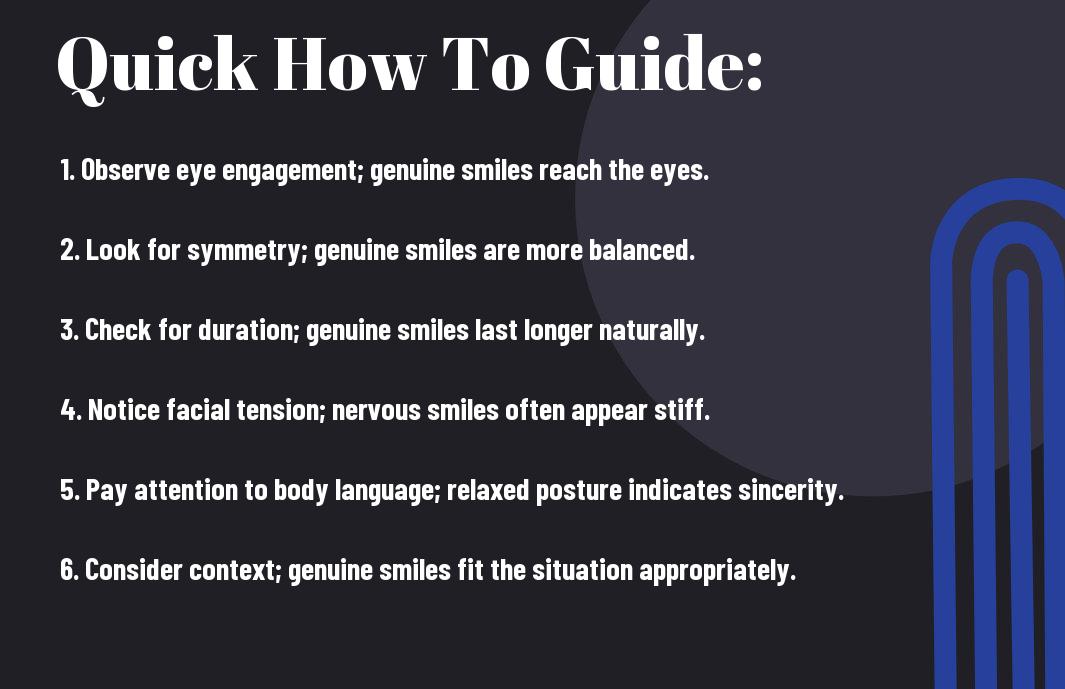Many people struggle to differentiate between a genuine smile and a nervous one, yet this skill can significantly enhance your interpersonal connections. By observing key facial movements and understanding the nuances of body language, you can better interpret the emotions behind a smile. In this guide, you will learn to recognize the subtle differences that define authentic happiness compared to anxiety, enabling you to respond more effectively in social situations. This knowledge will empower you to foster deeper, more meaningful interactions in both personal and professional contexts.
Understanding Genuine Smiles
To recognize a genuine smile, you must look beyond the surface. A true smile involves more than just the lips; it engages the eyes and can signal kindness, happiness, or sincerity. When you familiarize yourself with the nuances of a genuine smile, you can better distinguish it from nervous or forced smiles, allowing for more meaningful connections in social interactions.
Characteristics of a Genuine Smile
There’s a distinct difference between a genuine smile and other types of smiles. Genuine smiles, often referred to as Duchenne smiles, involve the movement of the zygomaticus major (the muscle responsible for smiling) and the orbicularis oculi (the muscle around your eyes). This combination creates a warmth in your expression that goes beyond mere lip movement and reflects a true emotional response.
Psychological Factors Behind Genuine Smiles
Smiles are influenced by various psychological factors that can indicate their authenticity. Genuine smiles often arise from feelings of joy, contentment, or connection with others. Some characteristics include:
- Spontaneity: Genuine smiles are typically spontaneous and occur naturally in enjoyable situations.
- Involvement of the Eyes: When you smile genuinely, your eyes become involved, often crinkling at the corners.
- Positive Emotions: Genuine smiles reflect positive emotions, making them vibrant and engaging.
The context and emotions behind your smile play a significant role in its genuineness.
Genuine smiles can serve as a social bonding tool, bridging the gap between you and others. They often occur in response to positive interactions or sentiments and can enhance feelings of trust and empathy. Some key points to consider include:
- Reciprocity: A genuine smile often invites a smile in return, creating a positive feedback loop.
- Emotional Resonance: Your genuine smile can convey empathy and shared happiness, strengthening social bonds.
- Cultural Context: While smiles are generally universal, cultural differences can influence how they are perceived and expressed.
The authenticity of your smile can significantly affect your social experiences.

Recognizing Nervous Smiles
Assuming you’ve ever found yourself in a tense situation, you may have noticed that not all smiles convey warmth. Nervous smiles often come across as forced or fleeting; they lack the natural ease of a genuine expression. When you’re engaging with someone in high-pressure moments, it’s important to discern these nervous smiles, as they can indicate discomfort or unease, rather than true happiness.
Signs of a Nervous Smile
On closer observation, you may identify several telltale signs of a nervous smile. These include a tightness around the lips, prolonged duration without accompanying joy in the eyes, and a quick retraction of the smile once the moment passes. Pay attention to any asymmetry or fleeting nature, as these are common indicators that the smile isn’t genuinely felt.
Common Triggers for Nervous Smiles
Smiles can often emerge in response to various stressors in your environment. When you encounter unfamiliar situations, such as meeting new people, presenting in public, or facing tough questions, your body may respond with nervous smiles as a defense mechanism, trying to alleviate tension.
Another factor that can contribute to nervous smiles is the pressure of social expectations. You might find yourself smiling out of habit or to fit in, even if you don’t feel comfortable. These smiles can often indicate feelings of anxiety or insecurity, particularly when you sense judgment from others or wish to appear more approachable in situations where you feel vulnerable.
How to Differentiate Between the Two
All smiles are not created equal, and understanding the subtleties between a genuine smile and a nervous one can enhance your social interactions. A genuine smile typically involves engagement from the entire face, while a nervous smile can appear tight and lack warmth. By tuning into these facial cues, you can discern the emotional intent behind a smile.
Observing Facial Patterns
Assuming you focus on the details of a smile, pay close attention to the eyes and the mouth. In a genuine smile, the eyes sparkle and may crinkle, while a nervous smile often reveals tension, with little to no eye involvement. The fullness of the smile can also indicate authenticity; a real smile feels natural and comfortable, whereas a nervous one may seem forced.
Contextual Analysis
If you find yourself trying to determine the authenticity of a smile, consider the situation context. A person may smile due to anxiety in a high-pressure environment, like during a job interview, which can lead to nervous smiles. Alternatively, in a relaxed or joyful setting, smiles are more likely to be genuine, reflecting true happiness and comfort.
Between various contexts, it’s crucial to evaluate the surrounding elements. Consider factors such as body language, the nature of the conversation, and the individual’s demeanor. A nervous smile may coincide with fidgeting or stiffness, while a genuine smile typically aligns with open, relaxed posture. Context adds significant weight to understanding a person’s emotional state, helping you assess the sincerity of their expressions more accurately.

Tips to Improve Your Smile Recognition Skills
After honing your eye for smiles, consider these tips to boost your skills:
- Observe facial cues beyond just the mouth.
- Practice with photos or videos of people smiling.
- Focus on the eyes; genuine smiles usually engage them.
- Experiment with different contexts to see how emotions change.
- Challenge yourself with resources like Can you spot a fake smile?
Recognizing true smiles takes patience and practice.
Practicing Observation
The key to developing your smile recognition skills lies in sharpening your observational abilities. Spend time watching people interact in various settings, such as social gatherings or public places. Take note of how different smiles manifest in relation to the environment and the emotions being expressed. With consistent practice, your brain will start to identify patterns and subtle differences.
Engaging with Different Personalities
An effective way to enhance your understanding of smiles is by interacting with people of various personalities. Each individual expresses emotions differently, and recognizing these nuances will improve your skills dramatically. Focus on how introverts, extroverts, and ambiverts use smiles in considering social interactions.
Personalities play a significant role in how smiles are conveyed. For instance, extroverts may smile more readily and openly, while introverts might display more reserved smiles. Engaging in conversations with individuals of diverse backgrounds will deepen your appreciation for the subtleties in smiles, allowing you to discern between genuine and nervous expressions more accurately. As you broaden your spectrum of experiences, your smile recognition abilities will sharpen, making you more adept in social settings.
Body Language and its Role
Unlike verbal communication, body language often reveals your true feelings and intentions. It can provide context that helps you interpret a smile more accurately, as movements, posture, and gestures can signal whether someone is genuinely happy or merely putting on a facade. By paying attention to these non-verbal cues, you can better differentiate between authentic and nervous smiles, enriching your understanding of interpersonal interactions.
How Body Language Supports Smiling Cues
Role of body language is key when interpreting smiles. Genuine smiles often involve the whole face, particularly the eyes, which are more likely to crinkle when true joy is present. In contrast, a nervous smile may be accompanied by closed body language, such as crossed arms or averted gaze, signaling discomfort or anxiety. This combination of facial expressions and body posture provides vital insights into a person’s emotional state.
Integrating Body Language into Your Assessments
Body language can enhance your ability to assess smiles effectively. By observing how someone carries themselves alongside their facial expressions, you gain a more comprehensive view of their emotional state. Is their smile accompanied by open, relaxed posture, or do they appear tense and defensive? Noticing these details can clarify whether a smile is authentic or driven by nerves.
Into your assessments, start by consciously observing the interplay between facial expressions and other body signals. Look for congruence: does the person’s smile feel aligned with their posture and movements? If their body language seems at odds with the smile, consider the possibility of underlying anxiety or discomfort. By integrating this awareness into your interactions, you will sharpen your skills in reading people and enhance your overall communication effectiveness.
Common Misconceptions about Smiles
Once again, many people mistakenly believe that all smiles convey happiness or friendliness. In reality, your smile can often be misleading, lacking the genuine warmth associated with true joy. Understanding these misconceptions is important to accurately interpret the emotions behind a smile, allowing you to discern the authentic from the artificial.
Myths Surrounding Smiling Behavior
Misconceptions about smiles abound, leading to confusion about their real meanings. For instance, some think that a smile always indicates a person’s positive intentions, while others believe that smiling is purely an involuntary reflex. These beliefs can cloud your judgment, making it challenging to read the true feelings behind someone’s expression.
Clarifying the Distinction
Any attempt to decode a smile requires you to recognize the nuances between a genuine and nervous smile. Understanding the specific cues in each scenario helps you better grasp the emotional context behind a smile.
For instance, genuine smiles typically involve the entire face, with the eyes crinkling and the cheeks lifting, whereas nervous smiles may lack this full engagement and appear more restricted. When paying attention to these subtle cues, you can better navigate social interactions and enhance your ability to empathize with others’ emotions, ultimately leading to stronger connections.
Conclusion
With these considerations, you can effectively differentiate between a genuine smile and a nervous one. Focus on the eye involvement and the overall body language that accompanies the smile, as these elements provide context for the expression. A genuine smile typically engages the entire face, while a nervous smile may feel more constrained. By observing these cues, you can enhance your interpersonal skills, allowing you to better understand the emotions and intentions of those you interact with.










